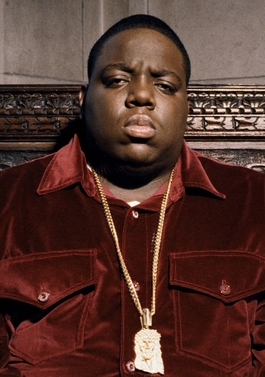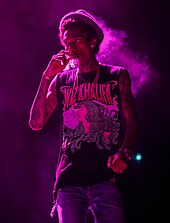Gangsta rap or gangster rap, initially called reality rap, is a subgenre of rap music that conveys the culture and values typical of urban gangs, reality of the world and street hustlers. Emerging in the late 1980s, gangsta rap's pioneers include Schoolly D of Philadelphia and Ice-T of Los Angeles, later expanding in California with artists such as N.W.A and Tupac Shakur. In 1992, via record producer and rapper Dr. Dre, rapper Snoop Dogg, and their G-funk sound, gangster rap broadened to mainstream popularity.

Rapping is an artistic form of vocal delivery and emotive expression that incorporates "rhyme, rhythmic speech, and [commonly] street vernacular". It is usually performed over a backing beat or musical accompaniment. The components of rap include "content", "flow", and "delivery". Rap differs from spoken-word poetry in that it is usually performed off-time to musical accompaniment. It also differs from singing, which varies in pitch and does not always include words. Because they do not rely on pitch inflection, some rap artists may play with timbre or other vocal qualities. Rap is a primary ingredient of hip hop music, and so commonly associated with the genre that it is sometimes called "rap music".

Christopher George Latore Wallace, better known by his stage names the Notorious B.I.G., Biggie Smalls, or simply Biggie, was an American rapper. Rooted in the New York rap scene and gangsta rap traditions, he is widely considered one of the greatest rappers of all time. Wallace became known for his distinctive, laidback lyrical delivery, offsetting his lyrics' often grim content. His music was often semi-autobiographical, telling of hardship and criminality, but also of debauchery and celebration.
West Coast hip hop is a regional genre of hip hop music that encompasses any artists or music that originated in the West Coast of the United States. West Coast hip hop began to dominate from a radio play and sales standpoint during the early to-mid 1990s with the birth of G-funk and the emergence of record labels such as Suge Knight and Dr. Dre's Death Row Records, Ice Cube's Lench Mob Records, the continued success of Eazy-E's Ruthless Records, Dr. Dre's Aftermath Entertainment, and others.
Southern hip hop, also known as Southern rap, South Coast hip hop, or dirty south, is a blanket term for a regional genre of American hip hop music that emerged in the Southern United States, especially in Georgia, Texas, Louisiana, Tennessee, and Florida—often titled “The Big 5,” five states which constitute the "Southern Network" in rap music.
Hip house, also known as rap house or house rap, is a musical genre that mixes elements of house music and hip hop music, that originated in both London, United Kingdom and Chicago, United States in the mid-to-late 1980s.

Nathaniel Thomas Wilson, better known by his stage name Kool G Rap, is an American rapper. He began his career in the mid-1980s as one half of the group Kool G Rap & DJ Polo and as a member of the Juice Crew. He is widely considered to be one of the most influential and skilled MCs of all time, and a pioneer of mafioso rap/street/hardcore content and multisyllabic rhyming. On his album The Giancana Story, he stated that the "G" in his name stands for "Giancana", but on other occasions he has stated that it stands for "Genius".
Underground hip-hop is an umbrella term for hip hop music that is outside the general commercial canon. It is typically associated with independent artists, signed to independent labels or no label at all. Underground hip hop is often characterized by socially conscious, positive, or anti-commercial lyrics. However, there is no unifying or universal theme – AllMusic suggests that it "has no sonic signifiers". "The Underground" also refers to the community of musicians, fans and others that support non-commercial, or independent music. Music scenes with strong ties to underground hip hop include alternative hip hop and conscious hip hop. Many artists who are considered "underground" today were not always so, and may have previously broken the Billboard charts.

The Canadian hip hop scene was established in the 1980s. Through a variety of factors, it developed much slower than Canada's popular rock music scene, and apart from a short-lived burst of mainstream popularity from 1989 to 1991, it remained largely an underground phenomenon until the early 2000s.

Golden age hip hop refers to mainstream hip hop music created from the mid or mid-late 1980s to the early or early-mid 1990s, particularly by artists and musicians originating from the New York metropolitan area. A precursor to the new-school hip hop movement, it is characterized by its diversity, quality, innovation and influence on overall hip hop after the genre's emergence and establishment in the old-school era, and is associated with the development and eventual mainstream success of hip hop. There were various types of subject matter, while the music was experimental and the sampling from old records was eclectic.

Enta da Stage is the debut album by American East Coast hip hop group Black Moon, released on October 19, 1993, through Nervous Records. The album was produced by Black Moon member DJ Evil Dee along with Mr. Walt of Da Beatminerz. Enta da Stage features the debut of underground hip hop duo Smif-N-Wessun, as well as appearances from Havoc of Mobb Deep and Dru Ha, the co-founder of Duck Down Records.

Illmatic is the debut studio album by the American rapper Nas. It was released on April 19, 1994, by Columbia Records. After signing with the label with the help of MC Serch, Nas recorded the album in 1992 and 1993 at Chung King Studios, D&D Recording, Battery Studios, and Unique Recording Studios in New York City. The album's production was handled by DJ Premier, Large Professor, Pete Rock, Q-Tip, L.E.S., and Nas himself. Styled as a hardcore hip hop album, Illmatic features multi-syllabic internal rhymes and inner-city narratives based on Nas' experiences growing up in the Queensbridge Houses in Queens, New York.
Hip hop is one of the most popular music styles in Bulgaria, especially among young people.
Dirty rap is a subgenre of hip hop music that contains lyrical content revolving mainly around sexually explicit subjects.
European hip hop refers to hip hop music and culture originating from Europe. Emerging in the 1980s following the genre's popularity in the United States, European hip hop has evolved into a diverse and influential musical movement. It encompasses a wide range of styles and subgenres, reflecting the continent's varied cultural landscapes and the experiences of both ethnic nationals and immigrant communities. Notable regional scenes include British hip hop and grime, German hip hop featuring both ethnic German and Turkish artists, and French hip hop, which has undergone several distinct eras of development. Other countries such as the Netherlands, Italy, Poland, and Romania have also produced significant hip hop scenes, each with its own unique characteristics and prominent artists.
Hip hop or hip-hop, also known as rap and formerly as disco rap, is a genre of popular music that originated in the early 1970s from the African American community. Hip-hop music originated as an anti-drug and anti-violence genre consisting of stylized rhythmic music that often accompanies rapping, a rhythmic delivery of poetic speech. In the early 1990s, a professor of African American studies at Temple University said, "Hip-hop is something that blacks can unequivocally claim as their own." By the 21st century, the field of rappers had diversified by both race and gender. The music developed as part of the broader hip-hop culture, a subculture defined by four key stylistic elements: MCing/rapping, DJing/scratching with turntables, breakdancing, and graffiti art. While often used to refer solely to rapping and rap music, "hip hop" more properly denotes the practice of the entire subculture. The term hip hop music is sometimes used synonymously with the term rap music, though rapping is not a required component of hip hop music; the genre may also incorporate other elements of the culture, including DJing, turntablism, scratching, beatboxing, and instrumental tracks.
Alternative hip hop is a subgenre of hip hop music that encompasses a wide range of styles that are not typically identified as mainstream. AllMusic defines it as comprising "hip hop groups that refuse to conform to any of the traditional stereotypes of rap, such as gangsta, bass, hardcore, and party rap. Instead, they blur genres drawing equally from funk and pop/rock, as well as jazz, soul, reggae, and even folk."
Chopper is a hip hop music subgenre that originated in the Midwestern United States and features fast-paced rhyming or rapping. Those that rap in the style are known as choppers, and rapping in the style is sometimes referred to as chopping. The style is one of the major forms of Midwest hip hop, though by the early 2000s, it had spread to other parts of the United States including California and New York City, and it has spread around the world since.
Drill is a subgenre of hip hop music that originated in Chicago in the early 2010s. It is sonically similar to the trap music subgenre and lyrically similar to the gangsta rap subgenre. Early drill artists are noted for their explicit, confrontational style of lyricism and association with crime in Chicago, especially the Black Disciples and Gangster Disciples. The genre progressed into the American mainstream in 2012 following the success of pioneering rappers like Chief Keef, Lil Reese, Lil Durk, Fredo Santana, G Herbo, Lil Bibby and King Louie, who had many local fans and a significant internet presence alongside producer Young Chop. Other rappers, such as Lil JoJo, FBG Duck, Edai, L'A Capone, RondoNumbaNine, SD and producer Leek-E-Leek also contributed to the early drill scene. The growing fanbase sparked major label interest, leading to deal negotiations and signings.

Illmatic, the 1994 debut album by Nas, made a significant impact on the hip hop genre. The album has been credited as one of the pivotal works that returned East Coast hip hop, particularly Queensbridge's hip hop scene, to prominence in a time when public attention was focused on West Coast releases. Nas' lyricism and storytelling on Illmatic has been regarded as setting a new standard for lyrical sophistication in major hip hop releases. The production of Illmatic has also been viewed as influential in cementing the characteristic sound of New York hip hop.












